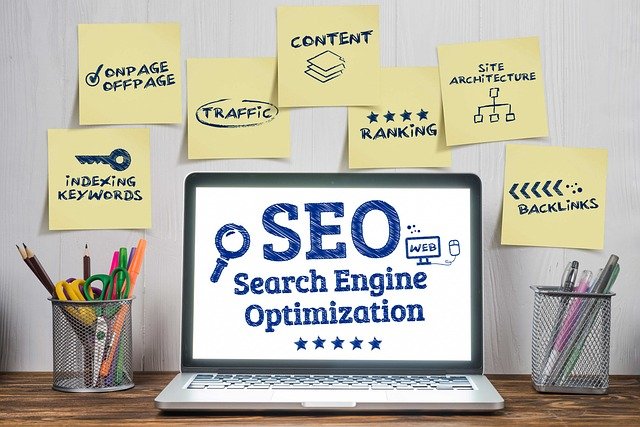Introduction
Search Engine Optimization (SEO) for E-commerce remains a cornerstone of successful digital marketing strategies, particularly for ecommerce websites. In 2024, the landscape of SEO has evolved, requiring ecommerce businesses to adapt to new trends and best practices to stay competitive. This comprehensive guide will walk you through the essential steps and strategies for optimizing your ecommerce website for search engines in 2024.
Understanding the Current SEO Landscape for Ecommerce

1. The Importance of SEO for Ecommerce
SEO for ecommerce websites is crucial for driving organic traffic, improving visibility, and increasing sales. With the ever-growing competition in the online retail space, having a well-optimized site is essential for standing out in search engine results pages (SERPs). SEO not only helps in attracting potential customers but also enhances the overall user experience, leading to higher conversion rates.
2. Key SEO Trends for 2024
As we move through 2024, several trends are shaping the ecommerce SEO landscape:
- AI and Machine Learning: Search engines are increasingly leveraging artificial intelligence (AI) and machine learning to deliver more relevant search results. This means that understanding and adapting to these technologies is crucial for effective SEO.
- Voice Search Optimization: With the rise of voice-activated devices, optimizing for voice search is becoming more important. This involves focusing on natural language and conversational keywords.
- Mobile-First Indexing: Google’s mobile-first indexing means that the mobile version of your site is considered the primary version for ranking purposes. Ensuring a seamless mobile experience is essential.
- User Experience (UX): Search engines prioritize sites that offer excellent user experiences, including fast loading times, intuitive navigation, and high-quality content.
On-Page SEO for Ecommerce Websites
1. Keyword Research
Keyword research remains the foundation of SEO. For ecommerce, this means identifying keywords that potential customers use to search for products. Here’s how to conduct effective keyword research:
- Utilize Tools: Use tools like Google Keyword Planner, SEMrush, and Ahrefs to discover relevant keywords with high search volume and low competition.
- Long-Tail Keywords: Focus on long-tail keywords, which are more specific and often less competitive. These can attract highly targeted traffic and increase conversion rates.
- Analyze Competitors: Examine the keywords that your competitors are targeting. This can provide insights into gaps in your own keyword strategy.
2. Optimize Product Pages

Product pages are critical for ecommerce SEO. Ensure that each product page is optimized for search engines by:
- Title Tags and Meta Descriptions: Craft unique and compelling title tags and meta descriptions that include primary keywords. These elements should accurately describe the product and encourage clicks.
- Product Descriptions: Write detailed, keyword-rich product descriptions. Avoid duplicate content by creating original descriptions for each product.
- Image Optimization: Use high-quality images with descriptive filenames and alt text. This helps search engines understand the content of your images and improves accessibility.
- Schema Markup: Implement schema markup to provide search engines with additional information about your products, such as price, availability, and reviews. This can enhance your listings in SERPs.
3. URL Structure
A clean and descriptive URL structure is important for both users and search engines. Ensure your URLs are:
- Descriptive: Include relevant keywords and avoid generic strings of numbers or characters.
- Short and Simple: Keep URLs concise and easy to read.
- Consistent: Maintain a consistent URL structure across your site to avoid confusion and improve crawlability.
4. Internal Linking
Internal linking helps distribute page authority across your site and improves navigation. Here’s how to optimize internal links:
- Link Relevant Pages: Use descriptive anchor text to link to related product pages, category pages, and blog posts.
- Create a Logical Hierarchy: Ensure your internal linking reflects the hierarchy of your site, with key pages easily accessible from the homepage.
Technical SEO for Ecommerce Websites

1. Site Speed and Performance
Page speed is a crucial factor in both SEO and user experience. Slow-loading pages can lead to higher bounce rates and lower rankings. Improve site speed by:
- Optimizing Images: Compress images and use appropriate file formats to reduce load times.
- Minimizing Code: Remove unnecessary code and use asynchronous loading for JavaScript and CSS files.
- Utilizing Caching: Implement browser caching and content delivery networks (CDNs) to speed up load times.
2. Mobile Optimization
With mobile-first indexing, ensuring that your ecommerce site performs well on mobile devices is essential. Focus on:
- Responsive Design: Use responsive web design to ensure your site adapts to various screen sizes and devices.
- Touch-Friendly Elements: Ensure buttons and links are easy to click on mobile devices.
- Mobile Load Times: Optimize mobile page load times to enhance user experience.
3. XML Sitemaps and Robots.txt
XML sitemaps help search engines crawl and index your site more effectively. Create and submit an XML sitemap to Google Search Console and Bing Webmaster Tools. Additionally:
- Optimize Robots.txt: Ensure your robots.txt file doesn’t block important pages from being crawled and indexed.
4. Fixing Crawl Errors
Regularly check for crawl errors using tools like Google Search Console. Address issues such as broken links, 404 errors, and redirect chains to maintain a healthy site.
Off-Page SEO for Ecommerce Websites
1. Building Quality Backlinks
Backlinks from reputable sites can significantly boost your site’s authority and search rankings. Strategies for building quality backlinks include:
- Guest Blogging: Write guest posts for industry-related blogs and include links back to your site.
- Influencer Partnerships: Collaborate with influencers to get mentions and links to your product pages.
- Content Marketing: Create high-quality, shareable content such as infographics and research studies that naturally attract backlinks.
2. Social Media Integration

While social media signals do not directly impact SEO, an active social media presence can drive traffic and increase brand awareness. Engage with your audience on platforms like Facebook, Instagram, and Twitter to:
- Promote Content: Share new blog posts, product launches, and special offers.
- Encourage Sharing: Create engaging content that encourages users to share and link back to your site.
3. Online Reviews and Reputation Management
Online reviews can influence search rankings and consumer trust. Encourage satisfied customers to leave reviews and address any negative feedback promptly. Focus on:
- Managing Reviews: Respond to reviews professionally and use feedback to improve your products and services.
- Monitoring Brand Mentions: Track mentions of your brand online to manage your reputation and address any issues.
Local SEO for Ecommerce Websites
1. Optimize for Local Searches
Even if your ecommerce business operates online, local SEO can be beneficial if you have a physical location or serve specific geographic areas. Optimize for local searches by:
- Creating a Google Business Profile: Set up and optimize your Google Business Profile to appear in local search results and Google Maps.
- Local Keywords: Include local keywords in your content and metadata if relevant to your business.
- Local Citations: Ensure consistent NAP (Name, Address, Phone) information across local directories and listings.
Analytics and Monitoring
1. Track Performance
Use tools like Google Analytics and Google Search Console to monitor your SEO performance. Track metrics such as:
- Organic Traffic: Measure the amount of traffic coming from search engines.
- Keyword Rankings: Monitor the rankings of your targeted keywords.
- Conversion Rates: Analyze how well your site converts visitors into customers.
2. Adjust Strategies
Based on your analytics, adjust your SEO strategies to improve performance. Regularly review and update your content, optimize for new keywords, and address any emerging issues.
Conclusion
SEO for ecommerce websites in 2024 requires a multifaceted approach that combines on-page optimization, technical SEO, off-page strategies, and continuous monitoring. By staying updated with current trends and best practices, you can enhance your site’s visibility, attract more traffic, and ultimately drive more sales. Implement these strategies diligently, and your ecommerce website will be well-positioned to thrive in the competitive online marketplace.
FAQ’S
How do I SEO for an e-commerce website?
SEO for an e-commerce website involves optimizing product pages, categories, and overall site structure to improve visibility in search engines. This includes keyword research, on-page optimization (like title tags and meta descriptions), technical SEO (site speed and mobile-friendliness), and off-page strategies (building backlinks and managing reviews).
How do I get SEO results for ecommerce?
Achieving SEO results for e-commerce requires a comprehensive strategy that includes optimizing your website’s content, improving technical aspects, building high-quality backlinks, and ensuring a positive user experience. Regularly monitor your performance and adapt strategies based on analytics and industry trends.
What is ecom SEO?
Ecom SEO (e-commerce SEO) refers to the practice of optimizing an e-commerce website to rank higher in search engine results, driving organic traffic and increasing sales. It includes both on-page elements (like product descriptions and keywords) and off-page strategies (like backlink building).
How to do off-page SEO for an e-commerce website?
Off-page SEO for e-commerce involves building high-quality backlinks, engaging in content marketing, leveraging social media, and managing online reviews. Focus on acquiring links from reputable sites, creating shareable content, and fostering positive brand mentions.
Which eCommerce platform is best for SEO?
Platforms like Shopify, WooCommerce, and Magento are popular for their SEO capabilities. Shopify is known for its ease of use and built-in SEO features, while WooCommerce offers extensive customization options and Magento is known for its robust SEO capabilities for larger stores.
What is off-page SEO 2024?
Off-page SEO in 2024 involves strategies outside of your website that impact search rankings. This includes building backlinks, improving social media presence, managing online reviews, and ensuring brand mentions across various platforms.
How to create backlinks for off-page SEO?
Create backlinks by guest blogging, building relationships with influencers, publishing high-quality content that others want to link to, and submitting your site to relevant directories. Focus on obtaining links from authoritative and relevant sources.
What are the off-page SEO tools?
Tools for off-page SEO include Ahrefs, SEMrush, and Moz. These tools help analyze backlinks, track brand mentions, and monitor your link-building efforts.
How to learn SEO off-page?
To learn off-page SEO, consider taking online courses from platforms like Udemy or Coursera, following SEO blogs, and using SEO forums to discuss strategies. Practical experience through hands-on projects or internships is also valuable.
How to do SEO for e-commerce websites in 2024 free?
Implement free SEO strategies by conducting keyword research using tools like Google Keyword Planner, optimizing on-page elements (like meta tags and descriptions), and leveraging social media for promotion. Utilize Google Search Console and Bing Webmaster Tools for site performance insights.
e-commerce SEO checklist
An e-commerce SEO checklist includes keyword research, optimizing product and category pages, improving site speed, ensuring mobile-friendliness, building backlinks, and monitoring performance with tools like Google Analytics.
How to do SEO for e-commerce websites
To do SEO for e-commerce websites, focus on keyword optimization, product page enhancement, technical SEO (site speed, mobile optimization), and off-page SEO (backlinks and social media). Regularly review and adapt your strategy based on performance data.
E-commerce SEO
E-commerce SEO involves optimizing online store elements to enhance search engine rankings and attract more organic traffic. This includes on-page optimization, technical adjustments, and off-page tactics like link building and social media engagement.
eCommerce SEO agency
An eCommerce SEO agency specializes in optimizing online stores for better search engine visibility. They provide services such as keyword research, on-page optimization, technical SEO, and link building to drive traffic and increase sales.
E Commerce SEO course
An eCommerce SEO course provides structured learning on optimizing online stores for search engines. Courses cover keyword research, product page optimization, technical SEO, and off-page strategies, offered by platforms like Udemy and Coursera.
SEO for e-commerce product pages
SEO for e-commerce product pages involves optimizing title tags, meta descriptions, product descriptions, images, and implementing schema markup. This helps improve visibility in search results and enhances user experience.
eCommerce SEO tools
eCommerce SEO tools include Google Analytics, Ahrefs, SEMrush, and Moz. These tools help in keyword research, backlink analysis, and tracking performance metrics.
How to build 100 backlinks in 30 days or less?
To build 100 backlinks in 30 days, focus on guest posting, creating shareable content, leveraging influencer partnerships, and submitting to relevant directories. Consistent outreach and content promotion are key strategies.
Can I rank my website without backlinks?
Ranking without backlinks is challenging but possible, especially for low-competition niches. Focus on high-quality content, technical SEO, and strong on-page optimization. However, backlinks generally enhance credibility and rankings.
Does Google allow backlinks?
Yes, Google allows backlinks. They are a crucial factor in search rankings, provided they come from reputable and relevant sites. Google values quality backlinks as endorsements of your content’s authority.

